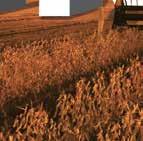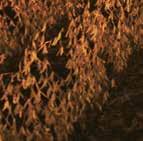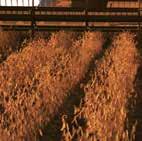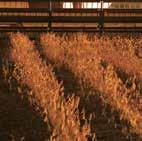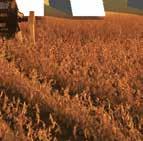

CREATING A FUTURE WORTH GROWING
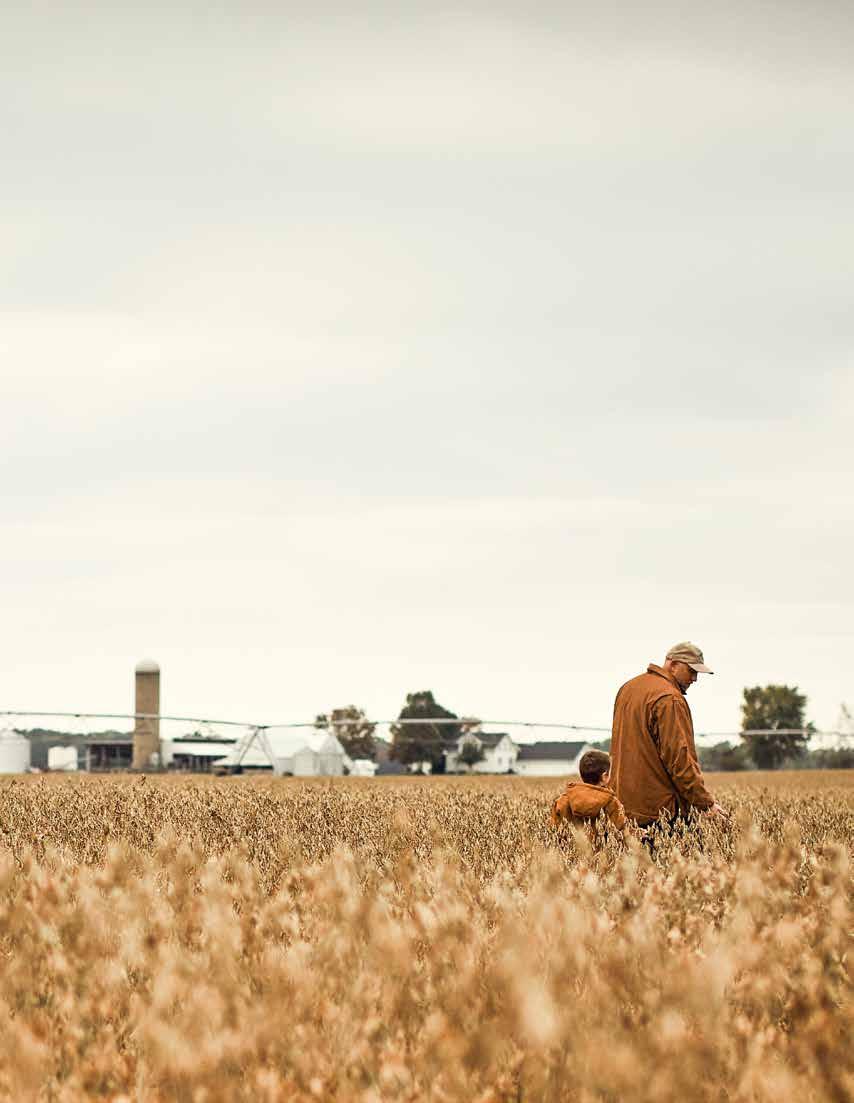
From the first sale of U.S. soy to China to the release of the first soybean oil-based tire, the soy checkoff has been behind the scenes, growing new opportunities and customers for the soybeans you produce. We’re looking inside the bean, beyond the bushel and around the world to keep preference for U.S. soy strong. And for U.S. soybean farmers like you, the impact is invaluable.
See more ways the soy checkoff brings value to farmers at unitedsoybean.org
o

o


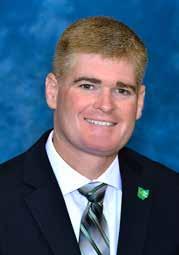
AAdam Graham
Ohio Soybean Association Chairman Logan County soybean farmer
A Letter From the Chairman
s we welcome 2018, I want to highlight a few Ohio Soybean Association (OSA)-related items from the past year. I’m proud of the work OSA has done! In the area of water quality, OSA has advocated continuously for science-based solutions that consider farmers’ nutrient needs so they can continue to grow a profitable and plentiful crop while also protecting the environment.
We have also advocated for a stronger Renewable Fuels Standard that continues to increase demand for soybeans, as well as increased market access and free trade agreements. With exports accounting for 62% of all U.S. soybean production, it’s also important that we continue to fight for swift approval of new biotech traits both here and internationally.
Here in Ohio, we supported important reform of the Current Agricultural Use Value, or CAUV. This was a huge success this year for farmers as that reform was included in the 2017 state budget bill. It will ensure that the CAUV calculation ties directly to the agricultural economy.
Finally, this past November OSA board members lobbied state legislators in Columbus. We met with members of both the Ohio House and Senate and talked about important issues to Ohio agriculture including water quality, biodiesel and fuel quality standards. This will officially be my last Chairman's letter as Todd Hesterman, previous OSA President, was elected Chairman. Thank you for your continued support of OSA, and on behalf of the entire Board of Directors, we wish you a safe and happy 2018!
Sincerely,
Adam Graham
Ohio Soybean Association Chairman Logan County soybean farmer
President
Allen Armstrong, Clark County
First Vice President
Scott Metzger, Ross County
Vice President
Ryan Rhoades, Marion County
Treasurer
Kerrick Wilson, Preble County
Secretary
Jennifer Wilson-Oechsle, Van Wert County
Chairman
Todd Hesterman
trustees
Jerry Bambauer, Auglaize County
Trish Cunningham, Knox County
Bret Davis, Delaware County
Adam Graham, Logan County
Caitlyn Heimerl, Industry Affiliate Ex-Officio
Patrick Knouff, Shelby County
Jeff Magyar, Ashtabula County
Jeff McKanna, Hancock County
Cindy Parker, Miami County
Derek Reusser, Holmes County
Jeff Roehm, Highland County
Luke Ryan, Lucas County
Andy Stickel, Wood County
American Soybean Association
Board Representatives
Jerry Bambauer
Bret Davis
Scott Metzger
Staff Credits
Kirk Merritt-Publisher
Jennifer Coleman-Editor
Katie Bauer-Contributing Editor/Staff Writer
Kayla Weaver-Contributing Writer
Donovan Harris-Design Director
Brent Warren-Senior Designer
Barry Falkner-Photo Quality/Proofer
Tony Green-Advertising Production
Ohio Soybean news is published six times a year by the Ohio Soybean Association, 918 Proprietors Rd., Suite A, Worthington, OH 43085. Phone: 614-476-3100. For address corrections contact Ohio Soybean News at 918 Proprietors Rd., Suite A, Worthington, OH 43085.
Web address: www.soyohio.org E-mail: cdeboard@soyohio.org
Comments and statewide news articles should be sent to the above address. Advertising space reservation must be made by the first of the month preceding publication. In consideration of the acceptance of advertisement, the agency and the advertiser must, in respect of the contents of the advertisement, indemnify and save the publisher harmless against any expense arising from claims or actions against the publisher because of the publication of the content of the advertisement.
For Advertising Sales Contact:
Matt Herman- (612) 812-5833
matt.herman@dtn.com


February 14-17, 2018
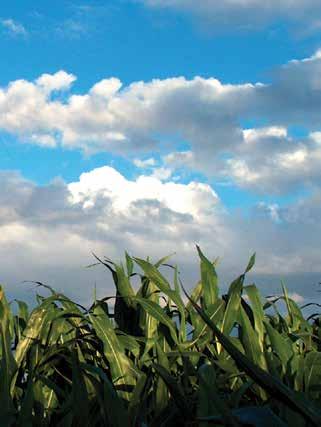






National Farm Machinery Show
Louisville, KY Kentucky Exposition Center Room 104 “C” South Wing

DTN: Trusted. Independent. Unbiased. Booth #2000
• Solutions that work where you do

• Independent information to boost profits
• Connecting you to the larger farm economy
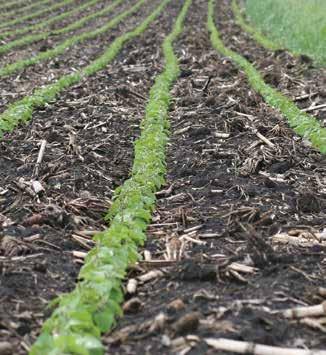


Don’t miss our DTN/The Progressive Farmer Seminar Series at the National Farm Machinery Show
Key information from the experts farmers trust the most.
Over the years, farmers have consistently turned to us for the information they need to make decisions that optimize success. Stop by our DTN/The Progressive Farmer Seminar Series at this year’s 52nd National Farm Machinery Show (NFMS) in Louisville, Kentucky and you’ll see why.
The Progressive Farmer 2018 National Farm Machinery Show


Business Seminar Series Room 104 “C” South Wing Conference Center
2018 Market & Weather Strategies
Presenters: Darin Newsom, Senior Analyst and Bryce Anderson, Ag Chief Meteorologist
The Progressive Farmer | 2:30 p.m. – 3:30 p.m.
Thursday, February 15th | 8:30 a.m. – 9:30 a.m. Friday, February 16th | 10:00 a.m. – 11:00 a.m.

@SF28430 | 11:30 a.m. – 1:00 p.m.

The Progressive Farmer
Presenters: Jeff Brown, Blue Mound, Illinois and Stuart Sanderson,

Friday, February 16th | 11:30 a.m. – 1:00 p.m.



Corn Yield Sponsor: Hosted by:
Corn Yield Sponsor:
Building Membership and Grassroots Advocacy

The ohio Soybean Association Thanks our Lifetime Members
Dave Allmandinger
Tony Anderson, Anderson Farms
Andrew Armstrong, Armstrong Farms
Basinger Farms Inc
Gary Bach
Gene K. Baumgardner, Ricketts Farm Inc
Curt Bibler
Wayne & Bob Cannon, Cannon Brothers Farms
Tim Carles
Carraher Farms Partnership
Matt Chatlain, Chatlain Farms
Dale Circle, Circle Farms
Joshua Clunk
Chris Collett
William & Jeff Coppess
Bret Davis, Davis Farms
Jason Davis
Keith E. Derck, Keith Derck Farm
Duane, Alan & John Dick, Cherwood Farms PLL
Dave Dotterer, Dotterer Farms
Matthew J. Durbin, Durbin Farms
Jay Fisher, J and S Farms
Bill Frankart, Ridge View Farms
Chad Gargas, PRD Partnership Farm
Jon & Scot Haar, Jon & Scot Haar Farms
Denny Hall, Hallwood Farm
Mark Hoffman
Terry C. Howell, Howell Farms LLC
Ellen Joslin, W R Joslin & Son Inc
Robert L. Keehner, Jr., Keehner Farms
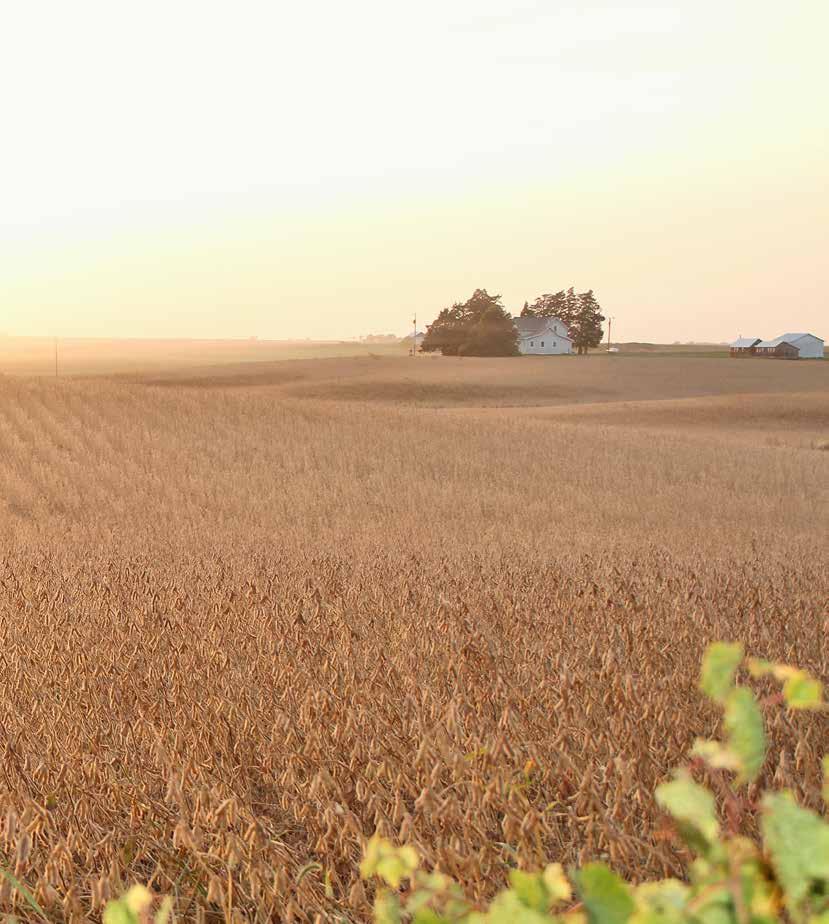
Ed Lamalie
John G. Landis, Landis Farms
Roger Lange, Lange Farms LLC
Dan & Nate Liskai, Liskai Farms
Paul Ludwig
Terry McClure, McClure Farms LLC
Laurel Meade
Daniel Michael
Robert L Miller
Hoover Farms Partnership
Stephen D. Pidgeon, Pidgeon Farms
John Ralph, Ralph Brothers Farms
John Rethmel
Roger L. Rupp, Rupp Seeds Inc
John Sawyer
Michael Scherger, Scherger Farms Inc
Donn E. Scheufler, Scheufler Farms LLC
Shoemaker-Webb Agri Business LLC
Joseph A. Steiner
Robert Stilwell, Stilwell Farms
Thomas Terrell, Woodside Farms
Bradley C. Terrill
Michael Tobe, Blanchard Valley Farmers Co-op
Douglas E. Utz
Jim VanTilburg, VT Farms LLC
Luke Vantilburg, Vantilburg Farms Inc
Mark W Wachtman, M & D Farms
Geraldine Walker
Kirk Walker
Albert Walton, R & M Farm Inc
Andrew Whiteleather, Whiteleather Grain LLC
Dennis J. Wischmeyer, Wischmeyer Farms
Aaron Zimmerman, Zimmerman Family Farms LLC
You too can become a lifetime member by signing up at www.soyohio.org/membership

Beck’s Young Farm Leader of the Year

Hank Wischmeyer
North Lewisburg, OH
“We try to be good stewards of the land and basically take care of what God’s given us.”
- Hank Wischmeyer
The Ohio Soybean Association (OSA) and Beck’s Hybrids are proud to announce that fourth quarter honoree, Hank Wischmeyer of Champaign County, was named 2017 Beck’s Young Farm Leader of the Year. The program highlights the important role of young farmers in the industry and recognizes those who are building strong foundations in agriculture that will help them lead the industry into the future.
“Hank’s dedication to agriculture is evident as he prepares to take on additional acres and responsibility as the next generation on the farm. He has an eye on the markets and international affairs and understands the importance of sustainability and advocacy for agriculture,” said OSA Chairman, Adam Graham.
Additional quarterly recipients for 2017 included:
- Ryan Tietje, Wood County
- Jarret O’Neill, Mercer County
- Travis Bahan, Union County
ohio Soybean Association 2018 Membership Incentives
As another successful year comes to a close, we want to take this moment to thank you for your continued support of the Ohio Soybean Association (OSA). As members of OSA, it is our mission to provide leadership for Ohio’s soybean farmers in advocating for effective policies and legislation to ensure a profitable and growing soybean industry. Your support helps advance the much-needed work of lobbying state and federal legislators on issues important to Ohio’s soybean farmers. In addition, we’ve added some exciting new benefits to our 2018 membership package. Below is quick
snapshot of all the benefits that you can take advantage of as a member of OSA. More information can be found at www.soyohio.org/membership.
1- and 3-year Members receive:
▶ 50% off retail of RoofMaxx™ Product
▶ Rebate coupon for $.05/gallon (up to 2,000 gallons) of soy biodiesel
▶ Entered to win 50hrs with CAT tractor
▶ Subscription to Ohio’s Country Journal
▶ Subscription to Ohio Farmer
▶ Membership to American Soybean Association and all member benefits
▶ 10% discount on any DTN/ The Progressive Farmer product or Ag Summit
For 3-year Members only:
▶ $200 coupon toward the purchase of a minimum 100 bags of soybean seed from participating company
Your OSA membership may have expired on January 1, 2018. A one-year membership is $80 and a three-year membership is $205. You also have the option of joining as a lifetime member for $1,000. You can renew your membership by calling (614) 476-3100 or online at www.soyohio.org/membership u








• Cabela’s Gift Cards:
For more information about OSA, visit www.soyohio.org/membership, or call 888-SOY-Ohio.


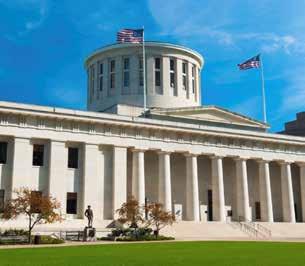


RESEARCH? SEARCH NO FURTHER.
The Soybean Rewards Program and the Ohio Soybean Council exist to give our state’s soybean farmers the knowledge to grow because increased expertise and improved practices in the field directly influence yields and crop quality. As you look toward your next growing season, we wanted to give you a quick preview of valuable research projects currently in the works at the Soybean Research Center at The Ohio State University.
DR. ANNE DORRANCE is working to identify the best disease management practices for our state’s challenging and changing pathogenic environments.
DR. LEAH MCHALE is looking at specialty cultivar breeds and new traits to increase yields.
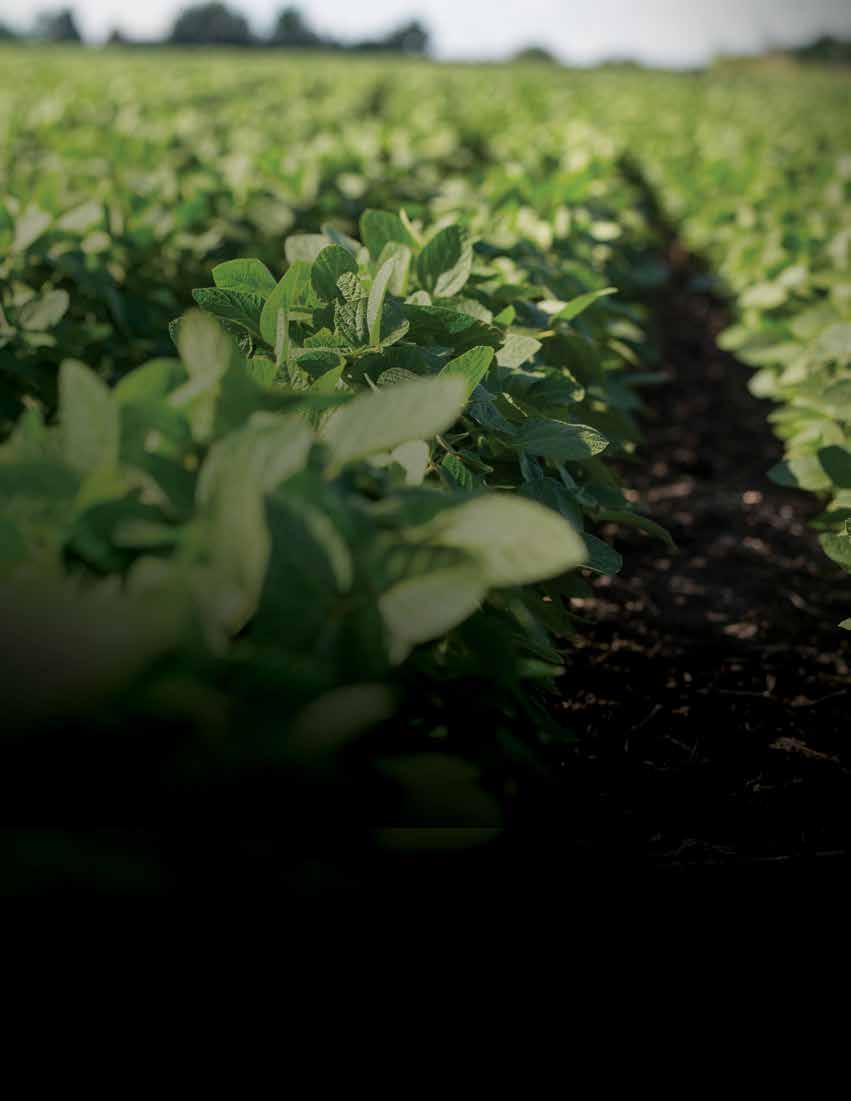
DR. KELLEY TILMON and DR. ANDY MICHEL are studying in-field control of stink bugs, aphids and other pests that threaten Ohio soybean yields.
DR. LAURA LINDSEY is surveying the effectiveness of mid-season foliar fungicide and insecticide treatments, applied alone and in combination. We’re here to keep your operation growing. Learn more anytime at SoybeanRewards.org.
Brought to you by Ohio soybean farmers and their checkoff.
©2017 Ohio Soybean Council
ASA Introduces New Class of DuPont young Leaders
The 34th class of American Soybean Association (ASA)
DuPont Young leaders recently began their leadership journey at DuPont Pioneer headquarters in Johnston, Iowa.
The Johnston training session was the first phase of a program designed to identify new and aspiring leaders within the agriculture community and provide them with opportunities to enhance their skills and network with other growers. Representatives from 19 states and Canada participated in the program.
“The Young Leader Program has had a tremendous impact on not only ASA but all of agriculture. We are very thankful for DuPont making this program possible,” said ASA President and Roseville, Illinois farmer Ron Moore. “The Young Leader program provides training in key leadership areas and allows participants to form lasting relationships with growers from across the country. This strengthens our industry and allows us to work collaboratively in our local, state and national organizations.”
The 2018 Young Leaders are: James Wray (AR); Jonathan Snow (DE); Rick Dickerson (DE); Joshua Plunk (IL); Chris Steele (IN); Chris Gaesser & Shannon Lizakowski (IA); Kevin & Kim Kohls (KS); Jared & Kimy Nash (KS); Clay & Lindsey Wells (KY); Caleb Frey (LA); Walter & Kristen Grezaffi (LS); Brian & Michelle Washburn (MI); Scott & Polly Wilson (MI); Adam Guetter (MN); James Locke (MS); Tyler Clay (MS); Dane Diehl & Erica Wagenknecht (MO); Kevin & Heather Kucera (NE); Scott Langemeier (NE); Philip Sloop (NC); Logan Ferry (ND); Justin Cowman (oH); Kevin & Brianna Deinert (SD); Jordan & Samantha Scott (SD); Charlie Roberts (TN); AJ Teal (TN) Pat Mullooly (WI); Tanner Johnson (TN); and Ann & Jeff Vermeersch (Ontario, Canada).
“It was a privilege to meet this year’s class of DuPont Young Leaders and talk with them about the challenges and opportunities facing American agriculture,” said Bart Baudler, Commercial Unit Lead — North & West. “We look forward to watching them continue to develop their leadership skills throughout the remaining parts of the program.”
This year’s class of Young Leaders will complete their training Feb. 25 –March 1, 2018, in Anaheim, California, with training held in conjunction with the annual Commodity Classic Convention and Trade Show. u
The 34th DuPont young Leader Class with ASA President John Heisdorffer, ASA Chairman ron Moore and DuPont’s Matt rejeweg.
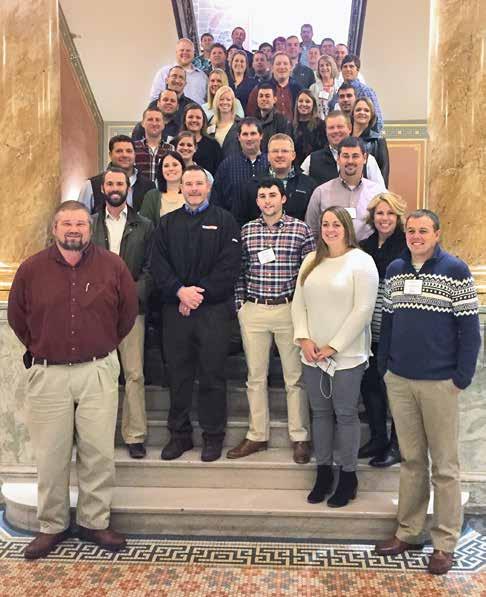
▶
ohio Soybean Industry Dinner Highlights
retiring ohio Soybean Council Board Members
Charlie Troxxell, Dan Corcoran and Terry McClure officially retired from the Ohio Soybean Council (OSC) Board of Trustees. Charlie lives in Clark County and has been on the OSC board for two years. During that time, he’s been an active voice and served as a member of the Communication Education Committee. He also serves as a Farm Service Agency board member for Clark and Madison County and is a member of the Clark County Farm Bureau. He farms more than 1,000 acres of soybeans and corn.
Dan Corcoran was recognized for his service to OSC and his tenure on the Board of Directors of the United Soybean Board (USB). A resident of Pike County, Dan joined OSC in 2002 and USB in 2009. He previously served as OSC Secretary, Treasurer, Vice Chairman and Chairman. Dan has been active in various committees both at the state and national levels. Dan owns Corcoran Farms with his three brothers where they grow soybeans, corn, wheat, and raise beef cattle. He is a 4-H advisor, religious education teacher, and youth basketball coach. Additionally, he is an advisor to The Ohio State University’s Research Soil & Water Quality Committee.
Terry McClure of Paulding County, Ohio served as Chairman of Ohio Soybean Council Board of Trustees. He also served as OSC Vice Chairman and Secretary. In addition to his volunteer leadership position with OSC, Terry is a member of the Board of Directors of Nationwide Mutual Insurance Company and a Trustee of the Ohio Chapter of the Nature Conservancy. Previously Terry was president of the Ohio Farm Bureau Federation, a board member of the Ohio Small Grains Marketing Program, American Farm Bureau and the Paulding County Soil and Water Conservation District. Terry is a fifth generation farmer and grows approximately 4,000 acres of corn, soybeans and wheat in northwest Ohio, along with raising 8,000 hogs for another farm operation.
▶ retiring ohio Soybean Association Board Members
There were four board members who retired from the Ohio Soybean Association (OSA) board and were recognized for their service.
Jim Heimerl of Licking County joined OSA in 2009 and has served on multiple committees. He farms more than 2,300 acres of soybeans, corn, and wheat, in addition to raising hogs and cattle. Jim is an active member of the Ohio Pork Producers, National Pork Producers and Hartford Fair Board.
Tommie Price lives in Putnam County where he grows soybeans and corn. During his time with OSA he served as Secretary, Treasurer, First Vice President, Chairman, and President. Tommie is active member of the Putnam County Farm Bureau Board and Paulding - Putnam Electric Co-Op. He’s also a former Putnam County Commissioner.
Bruce Simmons of Medina County was a long-time member of OSA joining in 2006. He farms soybeans and corn on more than 700 acres and is active in the Boy Scouts of America as a Scout Master. He holds a law degree from the University of Akron and volunteers as a baseball and basketball coach.
Jeff Sollars of Fayette County farms nearly 4,000 acres of soybeans, corn, and wheat. He joined OSA in 1999, and was a long-standing leader of OSA. He was also recognized for his tenure at the national level with the American Soybean Association Board of Directors, which he joined in 2009.
Jeff has proudly served as OSA President, Chairman, and Vice President. At the national level, Jeff has served on various committees including as Chair of the Commodity Classic Planning Committee.
▶ 2017 outstanding Achievement Award
Every year at the Ohio soybean industry dinner OSA and OSC recognize one person or organization that has significantly contributed to the Ohio soybean industry and
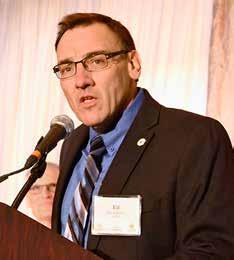
ed Anderson executive Director of the North Central Soybean research Program (NCSrP) accepted the 2017 outstanding Achievement Award on behalf of NCSrP at the 2017 ohio Soybean Industry Dinner.
created new opportunities for Ohio soybean farmers. The North Central Soybean Research Program (NCSRP) received the honor and Ed Anderson with NCSRP accepted the award. NCSRP is a farmer-led organization that invests soybean checkoff funds in university research and Extension programs to better understand and manage plant stressors that reduce soybean yield and farmer profitability.
▶ Key Note Speaker
This year’s key note speaker was Dr. Cathann Kress. Dr. Kress joined The Ohio State University on May 1, 2017 as the vice president for agricultural administration and dean of the College of Food, Agricultural, and Environmental Sciences. Before joining Ohio State, Dr. Kress was vice president for extension and outreach, and director of cooperative extension at Iowa State University. Dr. Kress has taught undergraduate and graduate students at all levels and her applied research efforts have focused on impacts on rural populations. u










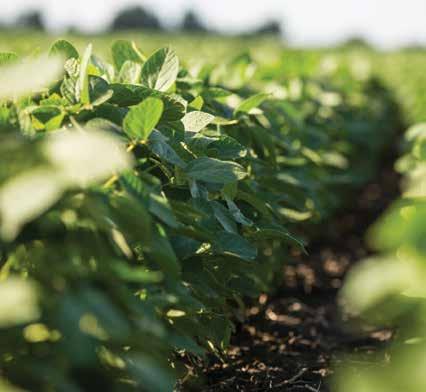



DRIVING DEMAND PAYS DIVIDENDS EVERY DAY.




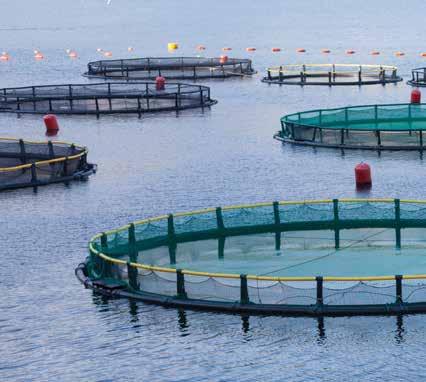





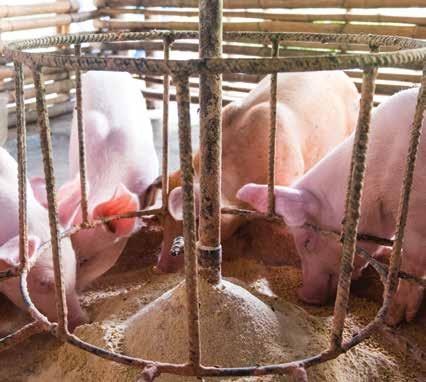
The Ohio Soybean Council is always looking for new ways to create demand for Ohio soybeans. In 2017, that meant collaborating with domestic and international partners on many exciting projects, including an all-natural, soy-based shingle rejuvenator that is spray applied to aging roofs, an innovative soybean meal that could revolutionize how fish are farmed and partnerships with the Ohio Pork Council, the United States Meat Export Federation and the USA Poultry and Egg Export Council to increase demand for pork and poultry across our state and around the world.
Check out how checkoff dollars are working for Ohio soybean farmers anytime at SoyOhio.org.
Kocher Livestock Invests in Animal Agriculture With Monoslope Cattle Barn
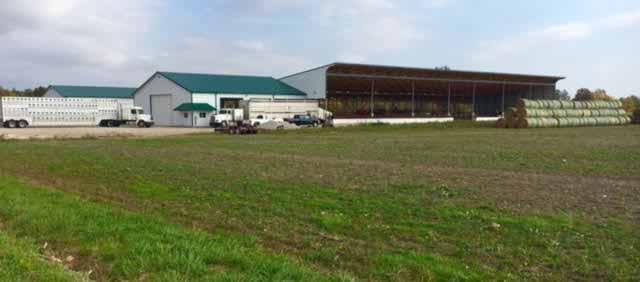
In the Kocher family, farming runs generations deep, but as Nick Kocher looked at returning to the farm after college in 2014 the Kochers knew they would have to expand MKB farms to sustain the addition of another family.
Nick’s parents Mike and Brenda Kocher have been farming on their own since the ’80s. While their operation, MKB Farms,
has always included a small number of cattle, they picked up the livestock part of their operation a little more around 1999 and decided to make an invest in the cattle business again this year.
“MKB Farms is our family farm; we grow a little more than 2000 acres of corn, beans and wheat along with feeding 850 head of cattle,” said Nick. “If we wanted to
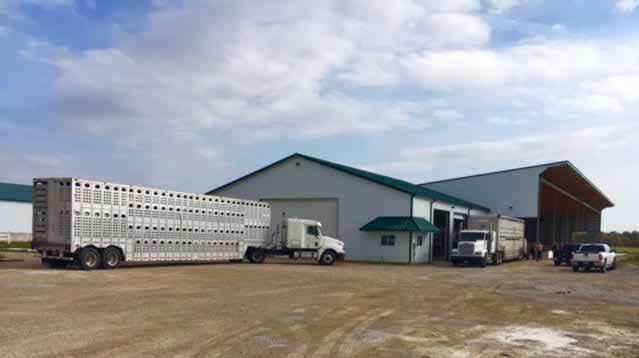
The Kocher family worked with Summit Livestock to install a forward thinking monoslope barn that provides many benefits to growing cattle such as natural ventilation.
just be grain farmers, there wasn’t enough land available for me to come back to the farm, so we had to do something else.”
After some deliberation, it was decided to expand the cattle operation and within a few years they had doubled their livestock herd.
“We considered hog barns and growing for someone else, but we wanted to set our own destiny and stay on our own. For us, beef prices seem to stay a little steadier than the crop market — livestock still fluctuates, but typically less so than crops,” said Nick, “And we’ve always liked cattle, so we went for it.”
MKB Farms works with Producer’s Livestock to transport cattle to and from their livestock facility on the farm.
The recent expansion included investing in a new facility for feeder cattle, which led to a unique solution in the form of a monoslope barn that can hold nearly 500 feeder cattle and is intended to increase cattle comfort and efficiency. Designed and built by Summit Livestock, the monoslope building allows sunlight to warm the cattle in winter, while the roof blocks the hot summer sun and the breeze can flow through.
The barn’s features keep the environment comfortable and predictable for the cattle to reduce stress and increase feed efficiency. Feeding patterns can be easily monitored to reduce waste and the structure provides covered manure storage.
“Right now, they’re all Holsteins; that’s not necessarily by choice, but economically they make more sense,” said Nick. “Lately most of the incoming cattle are around 650 pounds, but we’ve had some yearlings around 850 and can take them around 450 and still feed okay in our facility. We look at what makes sense at the time.”
To assist with inbound and outbound cattle, MKB Farms works with Producer’s Livestock to move cattle to and from the farm and provide market insight to help with decision making. In the last year, after a more local packing plant quit taking Holsteins, they began focusing more on contracting cattle when they come in to be sure they have a place to go when they leave.
Currently, the cattle are fed conventionally with corn and a supplement with soy meal. As demand for protein continues to rise, new opportunities and challenges may be around the corner in the form of consumer demands.
“We’re not all natural or organic, we don’t have any certifications for anything right now, but that’s not to say someday we wouldn’t,” said Nick. “It’s all economics, if they’re going to pay for it, we’ll consider it. You have to watch the consumer, even if you don’t understand or agree with it. As farmers, we have to supply what the consumers are asking for.”
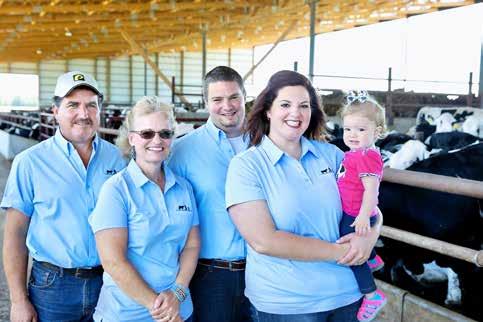
Over the years that has sometimes meant making some changes, such as implementing the new Veterinary Feed Directive policies this year. Requiring them to work more closely with their veterinarian, it has increased visits and associated costs, but they have also learned some things along the way and are getting things worked out as they go.
As a young producer, Nick is optimistic about the future of livestock production and believes we need to continue to work on export and import markets.
“I feel America has some of the highest standards when it comes to beef, and while I want to see them open up the markets, I think we need to have uniform standards for meat coming into the U.S. as well as the meat produced here,” said Nick.
He also considers additional challenges as a young or beginning farmer to be financing and cost of capital and inputs.
“Farmers who are established can get a loan easier than a young farmer, especially a new farmer trying to get financing can be difficult,” said Nick. “When my dad started in the ’80s you could buy ground for around $600 per acre and expect a 20-year return. Today you go out and buy ground for $7,000 an acre and look at a 30 or 40-year return.”
MKB Farms livestock operation includes (from left to right) Mike and Brenda Kocher, and Nick and Becca Kocher with their daughter Lucy.
“But it’s worth it. I like the sense of ownership and pride in owning something and being able to call my own shots. It’s stressful at times, but at the end of the day you’re doing it on your own terms,” said Nick. “That’s why I came back; I’m not an 8-5 person, I probably wouldn’t make it in one of those jobs. I’m always tinkering with something and trying to plan out the next big thing.”
In addition to growing the cattle herd, MKB Farms has been utilizing more cover crops to take a pro-active approach to nutrient management and are working on installing roller mill for feed to open new opportunities to increase efficiency and reduce cost. u
Investing Checkoff Dollars
ohio State Attends First Bioeconomy Conference
Over 40 Student Delegates, Faculty Mentors, and Leadership Team members of the Consortium for Advanced Bioeconomy Leadership Education (CABLE) have just returned from Advanced Bioeconomy Leadership Conference on Next Generation Technologies (ABLC Next) a conference dedicated to the most important issues in the bioeconomy, in San Francisco, California. Ohio State was represented by Associate Professor Leah McHale, Ph.D., and Sustainable Plant Systems major, Keeley Overmyer.
CABLE is a nationwide organization of universities focused on training students to pursue leadership positions in bioeconomy-related careers. The Ohio State University is leading the program and overseeing a $2.8 million grant from the United States Department of Agriculture (USDA). Overmyer is one of 20 Student Delegates, aided by a Faculty Mentor, spending a year in leadership training that includes one-on-one mentoring with current industry leaders, feedback on career preparation and academic training, internship and externship opportunities, and workshop and conference participation.
Next aims to be an action event with unparalleled networking and visualization. It’s a place where industry professionals within the emerging bioeconomy can discuss the latest technology and trends.
A key benefit for the CABLE group in attending ABLC Next was the first-hand access to high-ranking executives of top bioeconomy compa -
about the bioeconomy and become future industry leaders.
CABLE was created to develop bioeconomy industry leaders who will be ready to fill bioeconomy careers. Those future jobs include chemists, engineers, and scientists among others. Program Director Dennis Hall of The Ohio State University noted “The advanced bioeconomy is critical to a more sustainable future for society but largely invisible to all but a few college students. The ultimate goal is to equip more students with the knowledge and leadership skills necessary for successful biobased enterprises.”
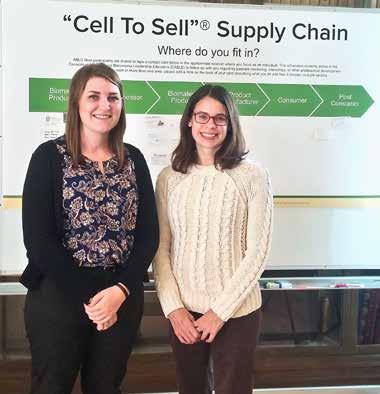
From left to right: Sustainable Plant Systems major, Keeley overmyer and Associate Professor Leah McHale, Ph.D. attend Advanced Bioeconomy Leadership Conference on Next Generation technologies.
During the conference, October 16-18th, McHale and Overmyer were presented with a unique opportunity to connect with existing bioeconomy industry professionals while furthering the CABLE program goal of leadership education. ABLC
nies and government agencies. From LanzaTech, DSM, and Aemetis to the USDA and the Department of Energy, the conference had tremendous value, especially for CABLE Student Delegates, who seek to learn more
CABLE Student Delegates have been split into four Working Groups that align with their education background and professional goals.
Keeley Overmyer is part of the State of the Industry Working Group that is led by two facilitators from the CABLE Leadership Team to assist throughout the year. Overmyer met her group at ABLC Next and was provided the first of many leadership development training sessions she will receive throughout her year assignment.
As Overmyer and this current cohort of CABLE Student Delegates progresses throughout the year, they will continue to receive close interaction and support from bioeconomy professionals. CABLE is intent on expanding the leadership education of students and aiding them in achieving their goals of becoming future bioeconomy professionals. u
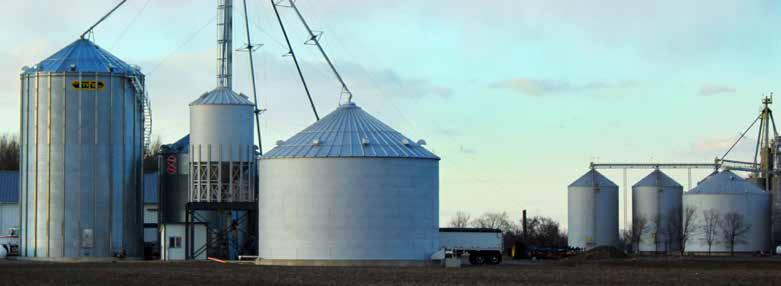
When is it Practical to Utilize Natural Gas in Agriculture?
Converting from Propane to Natural Gas
Farmers are continuously exploring ways to be more efficient on their farms, including the energy costs associated with grain drying. Propane is a clean-burning fuel source that can be effectively distributed to rural areas that lack access to natural gas infrastructure, which has made it an ideal fuel source for numerous agricultural operations. According to the National Propane Education and Resource Council, propane is used by nearly 900,000 farms across the country, powering roughly 80 percent of U.S. grain drying operations. However, Ohio is in the midst of an energy transition that has led many Ohio farmers to consider investing in natural gas infrastructure to support the energy demands of their farm operations.
Switching to Natural Gas
In most instances, large interstate or intrastate natural gas pipelines are under very high pressure that prevents local farms from tapping into them, but the presence of a smaller natural gas distribution line may make it cost-effective to switch from propane to natural gas. There are a number of considerations to determine if it makes sense to switch your farm from propane to natural gas:
• Proximity of the nearest natural gas line to your farm
• Fuel price
• Cost to extend the line
• Project planning and timing
• Peak demand—is there enough natural gas capacity for your farm during the drying season?
For More Information:
Energy price uncertainty and its relative cost in the production of crops has emerged as one of the greatest concerns for farmers. OSU Extension and the Ohio Soybean Council seek to provide resources and information that will help farmers make informed decisions regarding energy use on the farm. For further questions contact Barry McGraw at bmcgraw@soyohio.org.
Visit: energizeohio.osu.edu/farm-energymanagement/evaluating-natural-gasutilization-agriculture
Summaries will be presented at the following 2018 meetings:
Jan. 22 - Farm Economy Outlook
Emmett Chapel, Circleville, OH
Jan. 22 - Farm Economy Outlook
The Loft at Pickwick, Bucyrus, OH
Jan. 24 - Farm Economy Outlook
Holiday Inn, Worthington, OH
Jan. 26 - Farm Economy Outlook
Der Dutchman, Plain City, OH
Jan. 29 -Farm Economy Outlook, Jewell Community Center, Jewell, OH
Jan. 31 - Farm Economy Outlook
Fisher Auditorium, Wooster, OH
Feb. 8 - Agronomy School
Ol’ Zimms Wagon Shed, Gibsonburg, OH
Feb. 9 - Agronomy School
Bavarian Haus, Deshler, OH
Feb. 20 - Farm Management Series
Robert Fulton Ag Center, Wauseon, OH
Mar. 5 - Farm Economy Outlook
1025 Harcourt Rd., Mt. Vernon, OH
Mar. 23 - Farm Economy Outlook
Romers, Greenville, OH


Soy Contributes to Many Benefits of Light Curable Coatings
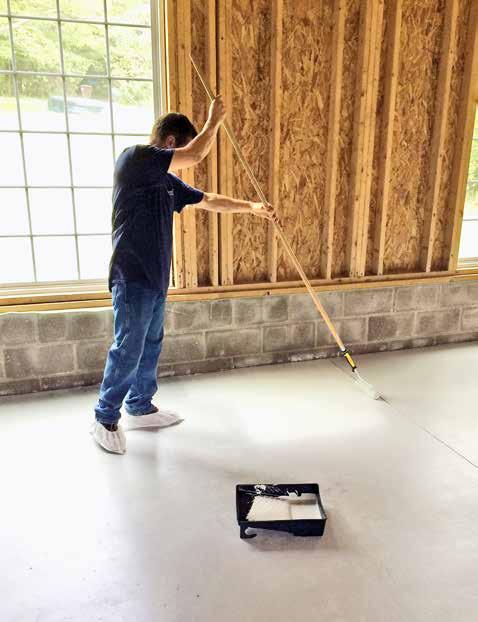
On any given day, a person may travel across numerous different surfaces without giving any thought to what’s under their feet. However, floor coatings are a $150 billion sector of the global market. With a new formula developed as part of research funded by the Ohio Soybean Council (OSC) and soybean checkoff
program, a new soy-based coating may be bringing part of that market share back to soybean farmers.
Light Curable Coating (LCC) is a small company based near Cleveland, in Berea, Ohio, and led by Dr. Ben Curatolo. Over the years LCC has developed a number of coatings that can be cured, or solidified, very quickly
The application process for LCC’s coating simply utilizes a roller to cover the surface area.
with ultraviolet light as an alternative to epoxy coatings.
Epoxy requires mixing two materials together — usually resulting in a strong odor — and typically requires a 24-hour waiting period before the surface can be utilized again. Surfaces that require two coats can be out of use for more than 48 hours. Light curable coatings are formulated to utilize ultraviolet light and harden in a matter of seconds — saving contractors and customers from extended down time.
Soybeans enter the picture as part of the light curable coating formula in the form of soy acrylate which is being
once applied the coating can be cured very quickly with the pass of an ultraviolet light and is ready for use almost immediately.
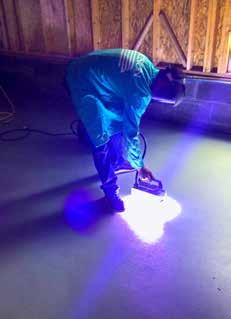
used as a major component in LCC’s product. With high percentages of soy acrylate, the coating meets standards to be designated as BioPreferred® based on USDA’s requirements for products made with renewable resources. Research has also verified that the soy acrylate formula performs very well and meets all industry specifications.
“We’re excited to harness the potential of another soy-based product that can both benefit farmers with increased demand and provide added value to end users in the form of bio-preferred designations and incredible amounts of time saved,” said Barry McGraw, OSC’s Director of Product Development and Commercialization. “Even modest success of this product could utilize more than 20 million bushels of soybeans per year.”
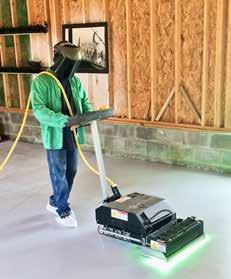
OSC funded research to identify the best formulation to take advantage of soy acrylate wrapped up in August of 2017 with LCC working toward the
first commercial sale by the end of 2017 with demonstrations and trade shows planned for the first half of 2018 to meet the goal of 50,000 square feet of coating sold by September.
To assist in the process, LCC has partnered with a Cleveland area coating contractor, Micah Sanders of Quick Cure Protective Coatings, LLC, to work on training and distribution of the materials and scaling up business operations.
Ultimately, the light curable coating should be cost comparative to current epoxy coatings and provide added value with environmentally friendly ingredients and quick curing times desired by industrial facilities that can not afford to shut down for 48 hours such as pharmaceutical production, automotive assembly or critical service centers like hospitals. u
ohio Soybean Farmers recognized as National Leaders
While one Ohio soybean farmer became immediatepast Chairman of the United Soybean Board (USB) this past December, another was elected to the Governing Committee of the American Soybean Association (ASA).
Ohio Soybean Association and ASA board member, Bret Davis, of Delaware County was elected during the December board meeting to the ASA Governing Committee. This committee is responsible for guiding ASA and implementing policies that align with the organization’s strategic plan. This is Davis’ third term on the nine-member leadership team.
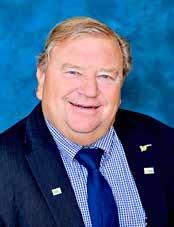
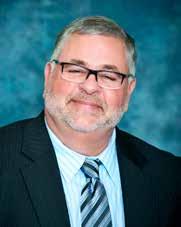
“The Ohio Soybean Association and Ohio Soybean Council are proud that such capable leaders have been able to serve our state and all U.S. soybean farmers at the national level,” said Kirk Merritt, OSA and OSC executive director.
This week also marked the end of Hancock County soybean farmer John
Motter’s term as USB Chairman. Motter was elected exactly one year ago as the 26th chairman in the organization’s history and the first Ohioan to hold the position. During his tenure, Motter has led USB forward on multiple programs and strategic directions, as well as leading the search for a new CEO.
“We thank John for volunteering so much of his time and energy, and will work to support Bret as he serves his 2018 term with ASA leadership.” u
John Motter served as USB Chairman Bret Davis was elected to the ASA Governing Committee
John Motter
Bret Davis


Canadian Pacific r ail e xtensions Bringing Potential to ohio
Ohio farmers produce high quality soybeans that are in demand for local and international markets. Often, one of the biggest challenges associated with international export markets is transportation. A new partnership between Canadian Pacific Railway Limited (CP), Genesee & Wyoming Inc. (G&W) and Bluegrass Farms of Ohio, announced in fall of 2017, could offer attractive new options for both producers and international customers.
The plans would allow CP to utilize Bluegrass Farms’ 90-acre intermodal facility located near the I-71 corridor which provides convenient access to Columbus, Cincinnati and Dayton markets connecting the Ohio Valley to the Port of Vancouver. Bluegrass Farms will maintain ownership of the facility and continue operations on behalf of CP as will a similar agreement with G&W who will service the site from its existing Indiana and Ohio line.
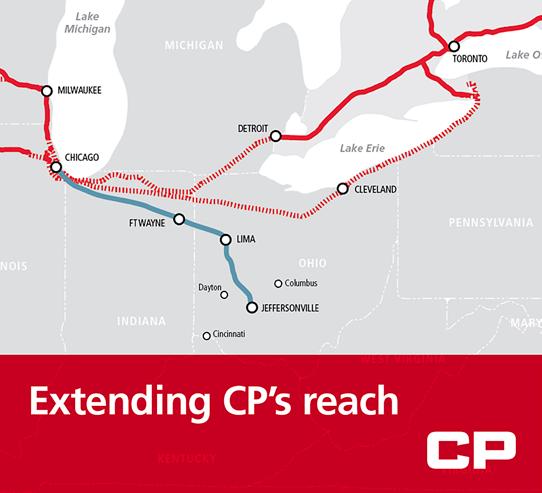
According to a company press release, Canadian Pacific President and CEO, Keith Creel said, “This service allows our international intermodal customers to come through the Port of Vancouver and access markets deep in the Ohio Valley. The unique site also creates better round-trip economics for our customers by enabling the empty containers to be re-loaded with agriculture products and shipped back overseas."
G&W Chairman, President & CEO, Jack Hellmann added that the
partnership is an excellent example of how short line railroads can extend the reach of the Class 1 network. And additionally provides backhaul opportunities that will enable customers to reduce overall transportation costs and enhance their competitiveness.
The partnership has created excitement from all who are involved as Dave Martin, President of Bluegrass Farms of Ohio, believes they have the perfect site to bring imports to the Ohio Valley while delivering high-quality, sustainable agricultural exports.
Expanding to the Ohio Valley is just one of the ways CP is working
Canada Pacific’s map outlines the short rail expansion that will bring additional marketing opportunities to ohio farmers international markets.
to meet the changing needs of the marketplace and leverage its services to expand markets and grow its business. CP is also working to expand its sales and marketing presence in Asia by adding key positions in China and Singapore which could help open more options for Ohio farm commodities. u
teaming up Proves to be a Win for Grain and Livestock Farmers
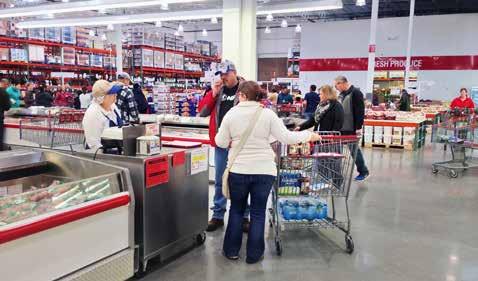
Being part of the agriculture industry means you’re a part of a community that works together and supports each other. Whether it’s a local farmer lending a hand to a neighbor in need, or commodity groups coming together for the good of the industry, farmers are often the ones who benefit.
Recently, the Ohio Soybean Council (OSC) and checkoff program took part in two separate promotions to help drive the demand for meat products in Ohio.
For the first promotion, OSC teamed up with the Ohio Pork Council (OPC) to encourage sales for pork products by collaborating with Costco stores around Ohio for in-store sampling events. Ranking in the top five US retailers for pork sales, Costco has 12 store locations in Ohio — all of which participated in the sampling on four different dates from September to November of 2017.
OPC’s sampling stations featured a variety of pork cuts including pork chops, pork sausage, pork tenderloin and boneless pork loin with half of the cost of the samplings being covered by support from a meat packer. In
addition, OPC was able to distribute key information and cooking tips about pork to consumers.
“When people eat Ohio pork, it also adds value to the soybean industry,” said Jennifer Osterholt, Director of Marketing and Education at OPC.
All twelve Costco stores in ohio participated in sampling throughout the fall and saw increased sales as a great return on investment for the ohio Soybean and ohio Pork Councils.
“Every market pig raised eats 3.7 bushels of soybeans, and in 2016 Ohio marketed more than 4.2 million pigs which utilized more than 15.5 million bushels of soybeans.”
Overall, results indicate the program was able to extend and move an additional 19,000 pounds of pork with each sampling event influencing an average of 34,000 people and creating positive percentage increases in pork purchases compared to days without in-store demos.
A second project partnered OSC with City Barbeque’s Powell, Ohio, restaurant for a unique scratch off promotion. With each order, customers
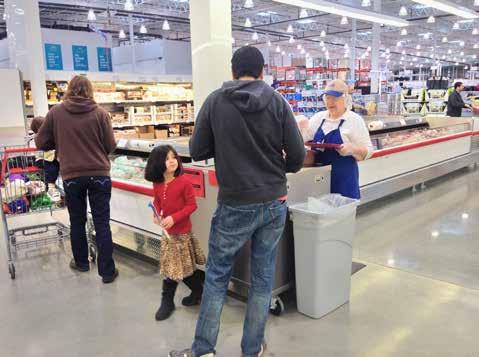
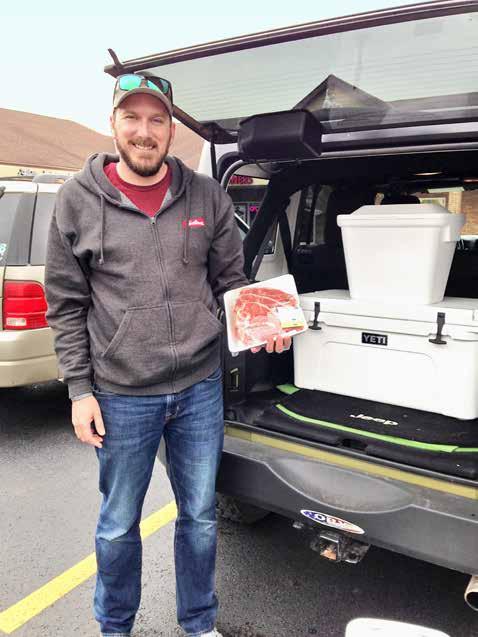
received a scratch off ticket with a chance to win prizes including gift cards to return to City Barbeque which were provided by the restaurant and a grand prize of a YETI cooler filled with premium meat products.
With a goal to increase the sale of meat products and get people excited about eating meat, City Barbeque was a great fit with a menu full of beef, pork, chicken and turkey and an owner who has an appreciation for agriculture. The Powell location was chosen for the pilot program with the hope its family-
centered clientele would have fun with the promotion.
Non-winning cards included facts about agriculture production and ways it contributes to Ohio’s economy. The program included a targeted digital social media campaign to raise awareness of the scratch card promotion as well as drive customers to the program’s webpage — MeatohioFarmers.org — where consumers can get contest rules, view profiles of a few local livestock farmers and learn more about OSC.
orie McCarthy found the winning scratch off card in December and received a yetI cooler and premium meats as the grand prize winner.
The ads successfully reached thousands of people in the targeted area and wrapped up with a final sponsored ad featuring grand prize winner, Orie McCarthy. While it is hard to make a direct correlation to the promotion, sales at City Barbeque’s Powell location did increase in 2017.
“Animal agriculture is the number one customer of U.S. soybeans. As the demand for meat products increases it also drives demand for soybeans; we value the relationship between the two sectors of agriculture and appreciate anytime we can team up for a common goal,” said Nathan Eckel, OSC board member and soybean farmer from Wood County. u

results of webpage data from MeatohioFarmers.org showed that people are visiting the page and engaging with the content available about farmers and agriculture.








